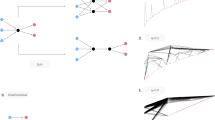Summary
This paper characterizes the optimal policy for a model in which manager may adopt an endogenous number of projects but has only limited resources to devote to their evaluation and maintenance. In any period, the manager may discard any subset of existing projects but may evaluate only one existing or one new project which is then either discarded or restored. Both its current return and the probability with which a project may be restored depends only on the number of periods since its last evaluated. For a manager whose objective is to maximize the sum of discounted returns, the optimal policy takes one of two forms. A “discard” policy specifies that the manager evaluate a new project in each period and discard current projects at some critical age. An “age inspection” policy specifies that the manager evaluate a new project only if all current projects are sufficiently young.
Similar content being viewed by others
References
Albright, S.: Structural results for partially observable Markov decision processes. Operat. Res.27, 1041–1053 (1979)
Barlow, R. E., Hunter, L., Proschan, F.: Optimal checking procedures. J. Soc. Indust. Appl. Math.11, 1078–1095 (1963)
Barlow, R. E., Proschan, F.: In: Mathematical theory of reliability, pp. 84–118. New York: John Wiley and Sons, 1965
Blackwell, D.: Discounted dynamic programming. Ann. Math. Statist.1, 226–276 (1965)
Cho, D. I., Parlar, M.: A survey of maintenance models for multi-unit systems. Europ. J. Operat. Res.51, 1–23 (1991)
Coase, R. H.: The nature of the firm. Economica4, 386–405 (1937) Reprinted In: O. E. Williamson (ed.) Industrial organization. Hants, England: Edward Edgar Publishing, 1990
Denardo, E. V.: Contraction mappings in the theory underlying dynamic programming. SIAM Rev.9, 165–177 (1967)
Eckles, J.: Optimum maintenance with incomplete information. Operat. Res.16, 1058–67 (1968)
Gifford, S.: Innovation, firm size and growth in a centralized firm. Rand J. Econ.23, 284–298 (1992)
Gifford, S.: Limited entrepreneurial attention and the optimal completeness of contracts. Working paper, Boston University, 1993a
Gifford, S.: Limited entrepreneurial attention and the internalization of transactions. Working paper, Boston University, 1993b
Gifford, S.: On the relationship between the venture capitalist and the entrepreneur. Working paper, Boston University, 1993c
Gifford, S.: Heterogeneous ability, career choice and firm size. Small Bus. Econ., forthcoming (1993d)
Glazebrook, K. D., Fay, N. A.: Evaluating strategies for Markov decision processes in parallel. Math. Operat. Res.15, 17–32 (1990)
Grossman, G. M., Shapiro, C.: Optimal dynamic R&D programs. Rand J. Econ.17, 581–593 (1986)
Holmes, T. J., Schmitz, J. A.: A theory of entrepreneurship and its application to the study of business transfers. J. Polit. Econ.98, 265–294 (1990)
Jensen, R.: Adoption and diffusion of an innovation of uncertain profitability. J. Econ. Theory27, 182–193 (1982)
Jensen, R.: Innovation adoption and diffusion when there are competing innovations. J. Econ. Theory29, 161–171 (1983)
Lee, T. K.: On the reswitching property of R&D. Manage. Sci.28, 887–899 (1982a)
Lee, T. K.: A nonsequential R&D search model. Manage. Sci.28, 900–909 (1982b)
Lovejoy, W. S.: On the convexity of policy regions in partially observed systems. Operat. Res.35, 619–21 (1987a)
Lovejoy, W. S.: Some monotonicity results for partially observed Markov decision processes. Operat. Res.35, 736–743 (1987b)
Lucas, R. E., Jr.: Optimal management of a research and development project. Manage. Sci.17, 679–697 (1971)
Luss, H.: Maintenance policies when deterioration can be observed by inspection. Operat. Res.24, 359–366 (1976)
Rosenfield, D.: Markov deterioration with uncertain information. Operat. Res.24, 141–55 (1976)
Sondik, E.: The optimal control of partially observable Markov processes over the infinite horizon: Discounted cost. Operat. Res.26, 282–304 (1978)
Wappanapanom, N., Shaw, L.: Optimal inspection schedules for failure detection in a model where tests hasten failures. Operat. Res.27, 303–317 (1979)
White, C.: A Markov quality control process subject to partial observation. Manage. Sci.23, 843–52 (1977)
Williamson, O. E.: The economic institutions of capitalism. Free Press, 1985
Author information
Authors and Affiliations
Additional information
Support from the C. V. Starr Center for Applied Economics and the Research Resource Committee of the Rutgers Graduate School of Management is gratefully acknowledged. We thank Roy Radner for valuable assistance in the early stages of the work.
Rights and permissions
About this article
Cite this article
Gifford, S., Wilson, C. A model of project evaluation with limited attention. Econ Theory 5, 67–78 (1995). https://doi.org/10.1007/BF01213645
Received:
Revised:
Issue Date:
DOI: https://doi.org/10.1007/BF01213645




